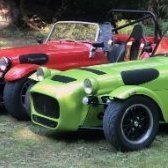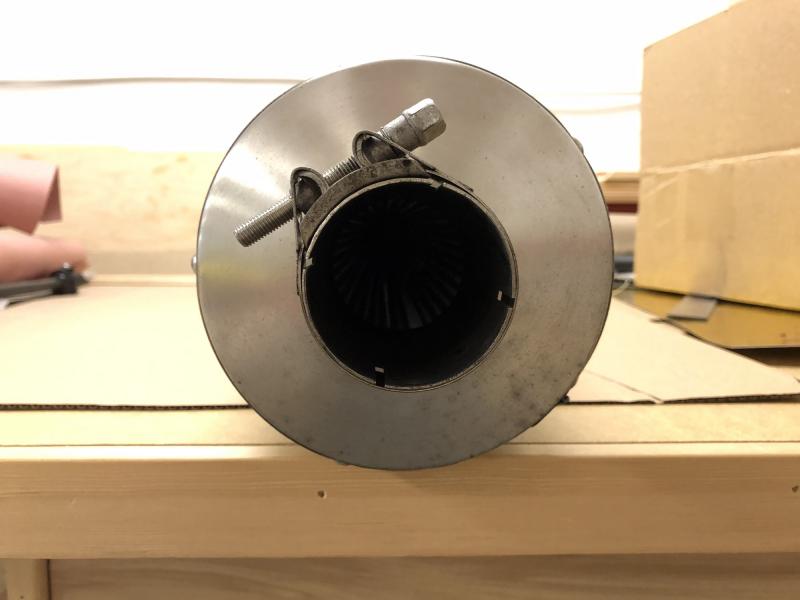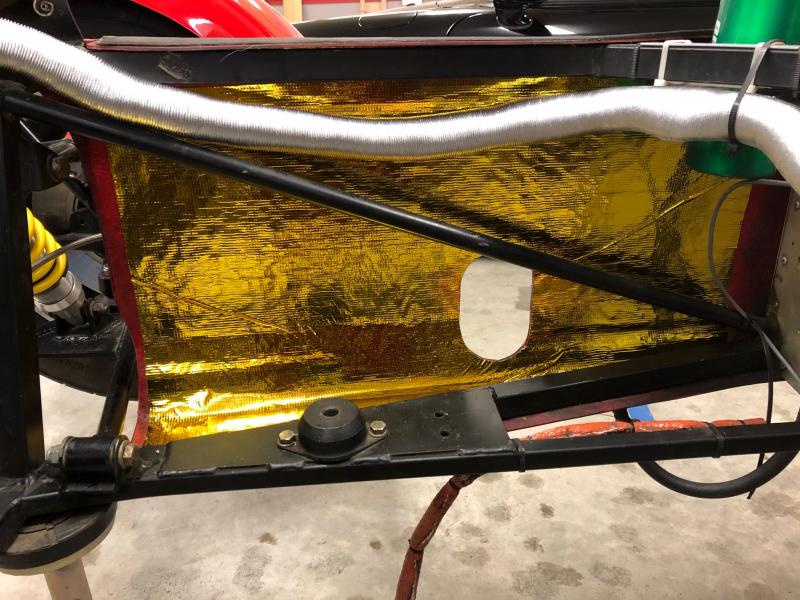-
Posts
3,087 -
Joined
-
Last visited
Content Type
Profiles
Forums
Store
Articles
Gallery
Events
Library
Everything posted by JohnCh
-
Assuming properly set up DCOEs and no issues, you shouldn't need a choke to start the car even in cold weather. Are you familiar with the DCOE cold start procedure? Let the the fuel pump prime the carbs (you'll hear the electric pump slow down when that's done), give the throttle 2 quick stabs to the floor, then crank with foot off the throttle. -John
-
Yes they are. In fact if they had shown up when expected, I would have been tempted to hang them from the tree BTW I meant to include weight measurements before. I haven't bothered to disassemble a factory piston/rod assembly, but the combined weight is 942 grams. A K1 rod with fasteners comes in at 518 grams and an Omega piston with rings and pin comes in at 410 grams for a total assembled weight of 928 grams. -John
-
Not much progress lately thanks to delays at the machine shop followed by even longer delays waiting for Raceline to ship the pistons. I like Raceline and appreciate the advice they offer via phone, but as long as I've been ordering from them (since 2003) getting things shipped has always been an exercise in frustration. Once the machine shop confirmed the piston size needed on 12/5, I called Raceline the next morning to place the order. Before taking my credit card number, they wanted to put together the package to establish an accurate shipping weight. This process took them until the 11th. Based on conversations, I expected it to go out within a couple of days, however, it didn’t ship until the 23rd. Fortunately there were no issues in customs and the pistons are now in the hands of the machine shop. Both SBD and Raceline sell the Omeg pistons, with SBD being a little cheaper (458 GBP vs. 475 GBP). However, I opted to go with Raceline since their tech support was a known quantity and there were a few minor maintenance items I still needed to order from them that would effectively ship for free if added to the order. Upon opening the box of pistons, I was a bit surprised to find a spec sheet from SBD included, and even more surprised to see the tops of the pistons stamped with both Omega and SBD branding. I guess there is no mystery about who provided Omega with the specs. I've been unmotivated to so some of the remaining small jobs, so decided to address something unrelated that has bothered me for a while. The standard Westfield boot box is a small item that drops down through the boot opening and is removable to assist working on the back end of the car. The problem with this design is that its dimensions are dictated by the size of that opening rather than by the space available in the tub. That space flares out as it approaches the fuel tank, mirroring the rake of the bulkhead in front, and the body to the rear. Wanting to take advantage of that space, I fabricated a custom boot box out of aluminum sheet that has a removable floor for maintenance, but holds roughly double the volume. It looked fine when new as shown in the photo, but over the years, that nasty, hard to clean, black oxidation that afflicts bare aluminum had firmly taken hold and would transfer onto anything left in the boot that slid against the sides. Given how I drive that car, anything in the boot is subject to a lot of sliding and thus a lot of black streaks. Sucking up the weight hit (~0.5 lb) I added some carpet normally used to cover subwoofer boxes. It looks good, is unbacked and much lighter than normal carpet, and it sticks to velcro meaning I could use that as the attachment method. We'll see how it holds up. -John
-
The head was dropped off at the shop about 3 weeks ago with a target of mid-December completion. This timing would allow me to reassemble and install the engine over my break the last half of December, but delays with the different machine shop doing the short block work have thrown that timetable out the window. The good news is that my spot there finally opened up last week and yesterday I learned they can address the damage in #1 mentioned earlier with a minor overbore. Although they said 0.25mm would do it, the Omega pistons come in a 0.5mm overbore, which means I'm going big and increasing displacement by a whopping 22.9cc. Raceline is pulling together the package of parts that includes the pistons, rings, o-rings/intake seals for the Jenvey throttle bodies, and the various replacement items needed to rebuild the wet sump. Hopefully pistons aren't held up in customs and I can have the car back on the road by late January/early February. That's a perfect time of year in the PNW to break in a new engine in a se7en and do road mapping (note to those who are sarcastically challenged: yes, that was sarcasm). Also an update on the journal damage pictured in post #2. Before dropping the short block off at the machine shop, I took a closer look at those specific bearings and noted a very subtle matching stain on the bottom shell which I missed during my initial inspection. The theory is that this staining resulted from the engine sitting for an indeterminate length of time before purchase. The machine shop said it's uncommon, but they've seen it before and don't have concerns, although to be fair they still haven't measured it to be 100% certain. I've asked them to do this before keying the crank. -John
-
Pricey, but much safer than normal 4-points and comfortable. Unlike some of the cheaper brands, Schroth webbing is quite pliable and their 1/4 turn buckles are easy to use. For track driving I use sub belts in a 6-point configuration, but for street driving, I stick with the 4-point option. The ASM technology is actually very simple: an extra flap of material is sewn into the inner shoulder belt. In a collision, the stitching breaks, leading your torso to slightly rotate outward, thereby placing your inside pelvis over the lap belt and preventing you from sliding underneath. The big danger from submarining is the lap belt effectively rides up your torso and can crush your unprotected organs. This video spotlights the safety difference: [video=youtube;8nsg_ze-CG8] -John
-
Based on the photo, the sloping one doesn't appear to leave much distance to the back of the driver's head. Is the straight one intended for taller drivers? -John
-
So to summarize, you were wrong. Glad I could help clarify. Shane, it's your turn! :jester: -John
-
Croc, are you thinking of a different manufacturer (or perhaps started your Gin & Tonic vacation a little early)? I bought my first ECU from Emerald in 2004 and upgraded that to K3 a few years later. Neither ECU was locked, the tuning software was free for anyone to download, they provide a free starter map based on their extensive library, and offered to speak with my dyno operators if needed. Great support and the software is very easy to use. When I installed my Duratec I rolled my own engine loom, but replaced that a couple of years ago with one from Emerald. Wish I did that from the start. Very well made, fully labeled, and they'll customize it to fit your installation. -John
-

The Regular Summary of Classified Ads of Se7ens Found For Sale
JohnCh replied to Croc's topic in Cars For Sale
Don't tell me you're one of those round earthers? That explains a lot... -John -

The Regular Summary of Classified Ads of Se7ens Found For Sale
JohnCh replied to Croc's topic in Cars For Sale
I checked with the Bintan and they assured me they have excellent internet access, so you'll be fine making your usual post next Sunday. Glad I could clear that up! :jester: -John -
The Raceco silencer has steadily increased in volume over the years and was clearly due for a rebuild. Disassembly showed the packing in the back 2/3 was in near perfect shape, but grew progressively worse towards the inlet end, with a several inch long section completely burned away. Raceco covers the core tube with a very fine mesh which adds life to the packing material, but which also burns away over time. Replacing the packing,but not the core tube when needed, simply ensures that the replacement packing won't have a long life. In the case of my silencer, the core tube was shot and replacement was mandatory. As long as everything was apart, a minor cosmetic restoration was undertaken to clean away grunge from years of exhaust leaks and to sand down the road rash from the grit and gravel sprayed from the right front tire. As you can see from the before and after photos, it still won't pass for new, but looks far more presentable. Thanks to very tight tolerances, reassembly was a bit fiddly, but it's back together and ready to go on the car once the engine and exhaust manifold are reinstalled. Unfortunately I'm still a few months away from those events and even further from hearing how it sounds. -John
-

The Regular Summary of Classified Ads of Se7ens Found For Sale
JohnCh replied to Croc's topic in Cars For Sale
Um...replica of what? -John -
Purely down to paranoia and cheap insurance. I knew that portion of the tub would be subjected to a lot of long term heat and I was concerned that over time there might be some discoloration or slight deformation of the fiberglass. I never would have done it if the primaries weren't snaked into that area so tightly. -John
-
With the engine out of the way, this is a good time to clean up the under bonnet area. First up was removing the peeling aluminized heat barrier cloth from the exhaust side of the tub and replacing it with gold heat reflective film. The heat cloth was originally affixed to the inside of the tub to protect the fiberglass from the heat of the primaries which are snaked into a very confined area. The gold film is supposedly just as effective as the aluminized cloth, but is a little lighter, and adds a touch of under-bonnet bling. I'm all about the bling. The header situation was foreshadowed in an earlier post. As previously mentioned, the header from Raceline fouled the right front wheel on full lock. Raceline decided it was better for me to have a local shop fabricate the replacement with my car on hand to ensure it would fit, rather than remake it themselves to measurements I supplied. The shop used the Raceline header for tubing diameter measurements and followed Raceline's instructions for tubing length. This is where things got interesting. Raceline explained that a Westfield has slightly more room for the secondaries than a Caterham, but for manufacturing simplicity, their Caterham and Westfield manifolds share the same dimensions. However, secondaries longer than supplied were better for performance. Given my car theoretically had room for slightly longer secondaries, they instructed the shop to make the primaries to their standard 30-31" length and the secondaries "as long as possible." The thinking was that my setup would gain perhaps 2" in secondary length. Seems simple enough, right? And remember, the shop had the original Raceline-supplied manifold on hand for a pattern. Imagine my surprise when I arrived at the shop to admire their work only to discover this: It seems they had taken Raceline's instructions as a challenge. Rather than follow the template of the Raceline header, which had gradual bends and placed about 1/3 of each primary tube outside the tub, they opted to snake the primaries to such a degree that those tubes and the collectors fit inside the tub allowing them to really make the secondaries "as long as possible." In this case that's about 21". Consensus among various Duratec tuners is this extreme length is probably costing power, but because no one seems to have tested such a setup on the dyno, it's not clear if it's a lot, a little, or if it is actually bumping up other areas of the torque curve with minimal impact to peak power. Next year, I plan to have this remade to a more conventional design with slightly larger tubing to take advantage of the cams, but first I'd like to spend some time becoming familiar with the new torque curve and extensively researching exhaust manifold design. -John
-
According to Toyo the sidewall of the RA1 is 10% softer than the R888. I've run both (albeit street-only) and prefer the RA1 as it feels a little more forgiving and adjustable mid corner. If Avon made tires in a size that works for my application, I'd definitely give them a try as I believe sidewall stiffness -- or lack thereof -- is an important characteristic for a car that's so light. -John
-
One of the reasons I'm at this stage for what should have been a simple oil pump change, is my aversion to the Duratec's lack of a key to lock the crank pulley and cam chain sprocket in place. Although the factory design, which relies entirely on friction washers and clamping force to keep things in place, does work, it's all too easy for a klutz like me to allow a degree or two of slippage when torquing down the bolt, thus affecting timing. It's also a little tough to do that process with the engine in the car or do it solo. Keying the crank assembly resolves those issues and provides additional assurance that no slipping will occur over time. There were a few options to have this work done. To minimize the risk of things turning out badly, I opted to buy pre-keyed crank pulley, timing chain sprocket and 3mm key from SBD in the UK, and then have a local machine shop cut the keyway in the crank to SBD's instructions. This approach added about $150 to the total, which I view as cheap insurance. As to why my aversion got me to this stage? Well, if you're going to remove the crank to key it, you might as well remove the pistons and rods and balance the assembly. If the pistons and rods are coming out, might as well replace them with something better. If new pistons that allow for greater valve lift are going in, it would be a shame not to replace the cams to take advantage of that. As long as bearings and seals are removed, replacement with new is an easy decision. Of course if those things are new, it would be a shame if another consumable like the water pump or clutch slave cylinder went out shortly after the car was back on the road, so might as well replace those too. Etc. Etc. Etc… John - Czar of the Slippery Slope
-
Hey, even i draw a line somewhere! -John
-
What? Mine was not enough? Fine, I'll wait for the master to arrive and show me how it's done... -John
-
Looks like you forgot the Pontiac Aztec. Surely worthy of a spot simply for how far it pushed accepted styling norms. Would we have the current Civic Type R if that suv was never penned? -John
-
If we decide to do end-of-year forum awards, this thread is a definite candidate for Thread Drift of the Year :jester: -John
-
Good call Sean. The balance shaft assembly attaches to that end of the block, so they likely needed to open up the area around the oil drains for clearance. -John
-
One interesting realization for me when looking at the Cosworth build manual is that there are physical design differences between the 2.3L and my 2.0L block. If you compare the left side and right side oil drains on the 2.3L as captured in the screenshot from the Cosworth manual, you will see they are different, whereas they are mirror images on my 2.0L. I wonder if this is a a running design change on all Duratec blocks or is a consistent difference between the 2.3L and 2.0L? [ATTACH=CONFIG]16170[/ATTACH] -John
-
The Lotus Elan and BMW 2002/1600 are notable omissions. They were both game changing when released and are still held in high regard more than 50 years later. I'd also add the Dino 246 GT, Alfa Romeo 8C 2900B, Lotus Elite (the original with a fiberglass monocoque, not the fat bastard namesake of the '70s) and Alpine A110 among others. -John
-
Raceline used the dome head screws due to clearance issues, so not enough room to use that option. The Torx head replacements should do the job, and if not, I'm keeping the phone number for the mobile welder on file Mike, someone provided a link to the Cosworth manual on another thread. I'll see if I can find it and add it here. Unfortunately the copy I downloaded is too big to attach to a post. EDITED: Found the link: http://duratecindetail.com/pdf/CSR260_Build_Manual.pdf -John














